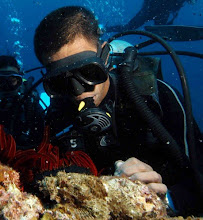
Fifteen perhaps twenty years ago the reef at Pulau Lima in Redang have much resemblance to the one I saw in Derawan today. Most shallow reefs at Pulau Paku is almost identical to Hin Daeng / Hin Muang in Thailand. I am puzzled with the transformation of our reef from such diverse eco-system into a reef thats dominated by mostly branching corals (mainly from genus Acropora). This process occurs within a period of twelve years.
Areas and parameters of comparison is established beginning from 1996 until 2009.
Areas I observed includes:
Tanjung Tengah (Redang, devastated by human activities)COT collection is frequent here
Pulau Paku (Redang, major areas of reef is overwhelmed by fast growing corals)COT collection is frequent here
Pulau Lima (Redang, major devastation in the northern side and in the south the reef is overwhelmed by branching acropora) COT collection is frequent here
Tanjung Tokong (Redang, slight devastation but maintained it diversity due to distance and less exposure to human activities)COT collection is occasional here
Tokong Laut (Perhentian, slow process of degradation is observed)COT collection is occasional here
Shark Point (Perhentian, reef is overwhelmed by fast growing corals, only at the deeper end where some diversity is observed)COT collection is occasional here
Tanjung Basi (Perhentian, shallower side totally overwhelmed by fast growing corals)COT collection is frequent here
Tanjung Butung (Perhentian, slight change in diversity in the shallower side)COT collection is occasional here
Karang Sela (Bidong, diversity never change) COT collection is NEVER done here
The Pinnacle (Pulau Yu Kecil, no change in diversity)COT collection is NEVER done here
Parameters I observed is the general appearance of the reef and its diversity. Other than that I also noted the human "conservation" activities in that period (12 years).
In the following I listed the conservation activities that I arranged according to their frequency.
Crown-of-thorns removal - annually, at random or in conjunction with other activities
Reef Check - Annually
Turtle related conservation - continually
Beach and Reef cleanups and Project Aware - annually, intermittently organized by dive centers
Awareness Drives and Outreach programs - seldom, in conjunction with other activities.
Impact on the reef directly related to the removal of COT is what I am addressing in this blog. Other activities is not described here as it could just divert your attention away from the topic.
After years of playing god and removing most of the COT on our reef we have:
1. Altered the diversity of the coral reefs and has allowed the fast growing corals like the branching acropora and pocillopora to overwhelm our reefs.
2. The loss of slower growing corals, soft coral and sea fan is quickly recolonized by branching acropora or just simply covered in zoanthids and algae.
3. Conditions 1 and 2 occurs only in areas where we frequently played god and removed the COT.
4. Exploration to Pulau Yu and Bidong area where COT are never been removed shows that the reef there never changed since 1996 until now!
The COT practices
We have never questioned if this COT removal practices is right or wrong. But we knew that sometime in 60s a young scientist from down under predicts that if the COT is let to exist the coral reef of the world will be gone on ten years. This is due to the extinction of the Triton shell which is known as the main predator of the COT. Since then it has been fifty years and the reef is still here! did anyone ever questioned or challenged the accuracy of this theory?
Ask this questions
Is Triton shell really is the only predator of the COT? or there are some other organisms, things or factors that help control the population of COT? Anyone care to find out? Why is that the COT did not just overwhelm all the reefs beyond human reach and destroy them? If COT is exterminated because they feed on corals, what about the drupella shells and the humphead parrotfish.. they feed on corals too. Why don't we exterminate them too?
Isn't it wrong to kill one living thing in favor of the other?
We did not belong in the ocean. We strapped a metal cylinder on our back and laid claims to the ocean. Can we decide what should live and what should die?
Who are we? Are we gods?
Enlighten me on this one folks!

 It has most of the basic shapes and a good object to start with my drawing. I begin with laying a line in the center of the object. This line will be my reference throughout the drawing process. I lay thin outlines to develop the first rectangle that makes the body of the spray bottle. Next I draw a half oval at the bottom section to create the base of the bottle. The same goes to the top section to create the bottle shoulder.
It has most of the basic shapes and a good object to start with my drawing. I begin with laying a line in the center of the object. This line will be my reference throughout the drawing process. I lay thin outlines to develop the first rectangle that makes the body of the spray bottle. Next I draw a half oval at the bottom section to create the base of the bottle. The same goes to the top section to create the bottle shoulder.
 r.
r. and the side of the lead is use to create the shade. The process is called "burnishing". Different pressure creates different shade.
and the side of the lead is use to create the shade. The process is called "burnishing". Different pressure creates different shade.



